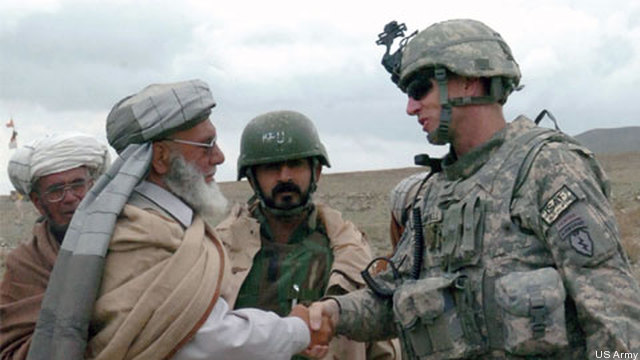NATO Advisors Must Stay In Afghanistan For ‘A Decade’ After 2014
Posted on

We aren’t leaving Afghanistan — except, of course, to the extent we are. That’s the high-wire balancing act that the top commander in Afghanistan, Marine Gen. John Allen, had to perform in his remarks today ahead of the upcoming NATO conference in Chicago.
“We will say to the Afghan people with one voice, ‘we are not leaving,’ and we will highlight our commitment to the Afghan National Security Forces beyond 2014,” Gen. Allen promised in the name of the alliance. Just minutes later, though, he announced that a second wave of U.S. troops “will start to depart the theater shortly.” 10,000 troops have already come home, and at least some commanders had hoped to hold the line there until 2014. Instead, Allen said, “[an additional] 23,000 will leave… by the end of September of this year.”
What’s going on? Ostensibly, Gen. Allen was speaking (via videoteleconference) to the Joint Warfighting Conference in Virginia Beach, VA. In reality, he has to address at least three audiences at once: the war-weary American public and politicians, who want out of Afghanistan as fast as possible; the deeply ambivalent Afghan government, which wants to end foreign interference without losing foreign support; and the insurgents of the Taliban, alert for any sign of weakness. Allen and other Administration spokespersons have to make the case that removing most US troops does not, and should not, lead inevitably to withdrawing them all.
So while many observers look to the December 2014 deadline to withdraw all “combat forces,” vaguely defined, as the end of America’s decade-long involvement in Afghanistan, Allen called it the beginning of “the decade of transformation.” For years after 2014, he said, “we can anticipate an enduring force, a NATO force [which] will continue the process of training, advising, and mentoring the Afghan National Security Forces.”
Allen’s second task was reassuring everyone that those Afghan forces are ready to stand — mostly — on their own, with much less outside help. “Today about 90% of our operations in Afghanistan are partnered,” that is with both Afghan and International Security Assistance Force (ISAF) troops involved, said Allen. “About 40% of those operations are Afghan-led.” That’s remarkable considering that the Afghan army and police didn’t exist a few years ago, but by the December 2014 deadline, 100% of operations need to be Afghan-led, with ISAF only acting as advisors.
Allen praised the Afghan National Security Forces (ANSF) for their neutral role in recent troubles between the Afghan people and their foreign allies, most dramatically the violent protests over contractors mistakenly burning copies of the Koran. “The ANSF stood their ground during those riots,” he said. “They stood between the rioters and the ISAF forces,” protecting both. “Some Afghan troops were actually killed in the riots…. Many of them were injured.”
The Afghan people have “a force that they can admire,” Allen said, and in polls, “the Afghan people have a very high opinion of their army and an increasingly high opinion of their police.”
Note the careful distinction here: The police are widely considered less effective and more corrupt than the army. But counterinsurgency strategy requires both. “All insurgencies are ended by police,” not soldiers, Allen emphasized. “If there isn’t a rule of law” — with functioning cops, courts, and jails — “then you can never reestablish order.” All are major problem areas in Afghanistan today.
“Corruption is going to be a problem,” Allen acknowledged. “It didn’t start last Tuesday and it won’t stop next Tuesday.” But, he went on — responding to critics who charge that President Hamid Karzai’s own relatives are a big part of the problem — “Pres. Karzai [has said] ‘we must all act together to attack this culture of impunity’; those are his words.”
Gen. Allen’s third audience is the Taliban itself, whose leaders the US has struggled to bring to the negotiating table and whose foot soldiers it is urging to quit fighting and just go home. Even as US forces draw down, he pledged, “we will relentlessly pursue this enemy.” Last year, he said, less than 700 former insurgents had passed through a “reconciliation” program designed to return them to civilian life, he said, but today, it’s over 4,100 and rising, thanks both to that “relentless” pursuit and to many insurgents’ reluctance to fight their countrymen as Afghan troops increasingly take the lead.
“The more of those people that go home, decomposing the movement from the bottom up, the more the political leadership of that movement” is under pressure to make a political deal, he argued. That’s the crucial bet the US is making as it withdraws.
Subscribe to our newsletter
Promotions, new products and sales. Directly to your inbox.
